Reminiscing

 When I first met my nephew, Riley Birky, he was a little boy…just ten years old. At that time, his mom, Rachel Schulenberg was just dating my brother-in-law, Ron Schulenberg. Riley officially joined our family when his mom and now stepdad got married on June 12, 2010. They became a blended family that day. Losing his mom to a stroke in January of 2021, was probably the hardest time in Riley’s life, and in the lives of his family. Riley is doing his best to be there for his family, and to make his mom proud of the man he has become.
When I first met my nephew, Riley Birky, he was a little boy…just ten years old. At that time, his mom, Rachel Schulenberg was just dating my brother-in-law, Ron Schulenberg. Riley officially joined our family when his mom and now stepdad got married on June 12, 2010. They became a blended family that day. Losing his mom to a stroke in January of 2021, was probably the hardest time in Riley’s life, and in the lives of his family. Riley is doing his best to be there for his family, and to make his mom proud of the man he has become.
Fast forward to the present day, and you will find that Riley is now a stepdad to his fiancée Sierah Martin’s son, Jace and a dad to their son, Ryder. Theirs is also a blended family with much love to go around. They started dating two and a half years ago, when Jace was about ten months old, but they have known each other for seven years now. Riley took to Jace as quickly and easily as he did to Sierah. They are best buddies, and I’m quite sure Jace thinks of Riley as his dad. I know Riley’s mom would be very proud of him, and she would absolutely love his family.
Riley is a hardworking man. Much of his working career has been in construction and maintenance. Growing up helping his grandparents with their rentals taught him the skills that would take him into the next chapter of his life. Riley isn’t afraid of hard work, and his main goal in life is to provide for his little family in the best way possible. In that, he has very much succeeded. Riley and his sweet little are very happy in the home they have made together. Now, with the joy of adding little Ryder, their family is complete.


Riley may be young, just 22 years old, but he has proven himself to be a good man, and the man that Sierah was looking for and needed in her life. Together, they will make a good home and life for their children, and I believe they will live happily ever after. They are focused on their family, and they are both going in the same direction. They both love to travel and have had a good time in their little trips over the past couple of years. Today is Riley’s 22nd birthday. Happy birthday Riley!! Have a great day!! We love you!!

 My nephew, Steve Moore has had an interesting year and a half. March of 2021 found Steve in a position that no active person ever wants to find themselves…with an injured hand. For Steve this was especially bad, because he likes to do so many projects with his hands, and to suddenly find himself sidelined was devastating. Nevertheless, Steve turned his attention to doing whatever was necessary to find his way back to being able to use his hand again. Really, it’s a good thing that occupational therapy is time consuming, because occupational therapy is a lot of work, and if you want to get back to full use of your hands, you have to work hard and commit to the program. Steve did that and now he’s back.
My nephew, Steve Moore has had an interesting year and a half. March of 2021 found Steve in a position that no active person ever wants to find themselves…with an injured hand. For Steve this was especially bad, because he likes to do so many projects with his hands, and to suddenly find himself sidelined was devastating. Nevertheless, Steve turned his attention to doing whatever was necessary to find his way back to being able to use his hand again. Really, it’s a good thing that occupational therapy is time consuming, because occupational therapy is a lot of work, and if you want to get back to full use of your hands, you have to work hard and commit to the program. Steve did that and now he’s back.
While Steve was unable to do the wood for his father-in-law, LJ Cook last summer, he has been able to get back at it this year. The vibrations from the saw really gave him a lot of trouble last year, but this year has been much better. He has built up the strength to almost 100%, and while the vibrations still bother him, it’s not enough to not run the saw. I’m sure that LJ is happy about that too. Getting and cutting up wood is a big job, and every hand is a big help.
Steve loves doing projects around the home he and his wife, my niece, Machelle Moore share. Earlier this 

 spring he did some work on the front of the house. This has been an ongoing project. The cement work was done about 5 years ago, and just they then had to wait to do anymore digging so the cement was well cured. They then had to move about 16 sprinklers, before they hand dug the front and side part of the cement area. They didn’t want to take a chance on cracking the cement by using equipment for the dig, so they did it all by hand. The plan was to move the rock out to the sidewalk all along, but it’s a big job, and they had to get motivated for it. This summer was the year. Maybe the time of sitting around made him want to get back to it. Anyway, it was time, and Steve tackled it and now it’s way better than what Machelle had envisioned. It’s amazing how much things like that came make you feel a sense of pride of ownership.
spring he did some work on the front of the house. This has been an ongoing project. The cement work was done about 5 years ago, and just they then had to wait to do anymore digging so the cement was well cured. They then had to move about 16 sprinklers, before they hand dug the front and side part of the cement area. They didn’t want to take a chance on cracking the cement by using equipment for the dig, so they did it all by hand. The plan was to move the rock out to the sidewalk all along, but it’s a big job, and they had to get motivated for it. This summer was the year. Maybe the time of sitting around made him want to get back to it. Anyway, it was time, and Steve tackled it and now it’s way better than what Machelle had envisioned. It’s amazing how much things like that came make you feel a sense of pride of ownership.
Steve is a good man to have around, as his in-laws, Debbie and LJ Cook, have found. He is the kind of guy who will drop everything to help someone out when they need it. Plus, he likes to build things, and he has a real knack for it. The raised gardens he built for his in-laws, have made their gardening so much easier on their 

 backs, and the fact that they are beautiful is a definite plus too. Steve stepped in to help Debbie and LJ with their freezer defrost project this past week too. That is a really hard job, and it’s always nice to have an extra set of hands. I know that Debbie and LJ really appreciated it. Steve is just a great guy to have around, and he has been a huge blessing to the Cook family. Today is Steve’s birthday. Happy birthday Steve!! Have a great day!! We love you!!
backs, and the fact that they are beautiful is a definite plus too. Steve stepped in to help Debbie and LJ with their freezer defrost project this past week too. That is a really hard job, and it’s always nice to have an extra set of hands. I know that Debbie and LJ really appreciated it. Steve is just a great guy to have around, and he has been a huge blessing to the Cook family. Today is Steve’s birthday. Happy birthday Steve!! Have a great day!! We love you!!
 War is often a very strange phenomenon. Some wars go on for years, while others for just one day. On such “war” was the infamous Kettle War. The war was between the Holy Roman Empire and the laughably outmatched Northern Netherlands and took place on October 8, 1784. The war was a one-battle wonder!! The events leading up to the war were a series of political upheavals and rebellions, culminating with the Northern Netherlands seceding from the Empire. That maneuver was one that would cut them off from some pretty important trading harbors. As you can imagine, Emperor Joseph II was none too pleased at this turn of events. In retaliation, he sent three warships to remove the blockade.
War is often a very strange phenomenon. Some wars go on for years, while others for just one day. On such “war” was the infamous Kettle War. The war was between the Holy Roman Empire and the laughably outmatched Northern Netherlands and took place on October 8, 1784. The war was a one-battle wonder!! The events leading up to the war were a series of political upheavals and rebellions, culminating with the Northern Netherlands seceding from the Empire. That maneuver was one that would cut them off from some pretty important trading harbors. As you can imagine, Emperor Joseph II was none too pleased at this turn of events. In retaliation, he sent three warships to remove the blockade.
Strangely, the Northern Netherlands sent only one ship, the Dolfijn. While three warships isn’t that many, it still seems foolhardy to send just one ship to take on three. Maybe it was an odd thing to do, but nothing compared to what was to follow. The battle began with a standoff. Then, the Dolfijn fired a single shot. The bullet hit no one. Strange as that is, what it did hit made the situation even more strange. The bullet hit a kettle of soup on the deck of enemy ship Le Louis. The kettle sprayed its passengers with the thick liquid. To me, that seems like a really bad shot, but that was not how the men on the Le Louis saw the situation very differently. It’s hard to say what might have been going through their minds, but the crew was instantly terrified. It’s not clear whether they were astounded by the accuracy of the shot or terrified of their apparently insane enemies, buy the Empire forces immediately surrendered. Three shiploads of military men surrendered after being missed by a bullet that basically spilled the soup. Explain that to the powers that be.
As a consequence of this short skirmish, and under the mediation of France, negotiations were reopened between the countries. This led in 1785 to the Treaty of Fontainebleau. It was decided that the Scheldt would remain closed to shipping, but that the southern Netherlands would be compensated for this by the Republic. At a rough estimate the Republic paid 2 million guilder (according to other sources 10 million guilder), which equates to 1,099,000 or 5,495,000 US dollars, depending on which estimate is correct. Soon, agreements were made between Belgium and the Netherlands about allowing access the Scheldt. As a result of the war came the decline and fall of Duke Louis Ernest of Brunswick-Lüneburg, who was the advisor to the Dutch stadtholder, who was accused of favoring the enemy due to his familial ties to Joseph. As for Belgium and the Netherlands, at least for now, there was a peaceful agreement on the use of the Scheldt.

 Looking back now, back to a time before the September 11, 2001 attacks, our nation had a very different feel…innocent maybe, but we had no reason to feel a lack of security. Then came that horrific day in September, when innocence was lost. Our nation was attacked…on our own soil, and that was not acceptable!! Of course, there would be retaliation. Those responsible would have to pay, and they did, but we also had to find a way to make sure this could never happen again.
Looking back now, back to a time before the September 11, 2001 attacks, our nation had a very different feel…innocent maybe, but we had no reason to feel a lack of security. Then came that horrific day in September, when innocence was lost. Our nation was attacked…on our own soil, and that was not acceptable!! Of course, there would be retaliation. Those responsible would have to pay, and they did, but we also had to find a way to make sure this could never happen again.
Enter the Office of Homeland Security. Founded on October 8, 2001, less than one month after the September 11th terrorist attacks…the hope was to be able to decipher the chatter that is always out there and if possible, stop any future attacks. While we would all agree that Homeland Security hasn’t done its job in the way we would like, there have been no major attacks on our soil. Any further inaction on their part could cause big problems, so we need to watch and pray over our nation.
Homeland Security is a department of the cabinet. It is the largest department of the federal government, charged with preventing terror attacks, border security, immigrations and customs, disaster relief and prevention and other related tasks. President George W Bush announced the creation of a new office to  “develop and coordinate the implementation of a comprehensive national strategy to secure the United States from terrorist threats or attacks” just ten days after September 11. The new director of the Department of Homeland Security (DHS), Tom Ridge assumed his role as director and the office opened on October 8, 2001.
“develop and coordinate the implementation of a comprehensive national strategy to secure the United States from terrorist threats or attacks” just ten days after September 11. The new director of the Department of Homeland Security (DHS), Tom Ridge assumed his role as director and the office opened on October 8, 2001.
Congress had their concerns about the new department, thinking it would add to the federal bureaucracy and dramatically re-organize the security state. Nevertheless, Congress officially voted to make the office a cabinet-level department in November of 2002. Eventually, 22 other departments were absorbed by DHS. Entities absorbed by DHS included the Secret Service, Customs and Border Protection, and even Coast Guard. The Department of Homeland Security has faced criticism for much of its brief history. It doesn’t really seem to be a very “well-oiled machine” as it were. The response to Hurricane Katrina, for example, was condemned by many, despite having been partly founded to coordinate a government-wide disaster response. Unfortunately, DHS reportedly did not develop such a plan until two days after Katrina made landfall…great timing, since they knew the hurricane was coming.


The DHS is inefficient in many ways, but I suppose that any government agency is…especially these days. Nevertheless, one thing can be said for them…up to now anyway. There has not been a major attack on American soil since they were formed. So, provided they continue to do that much, they are better than no security at all.
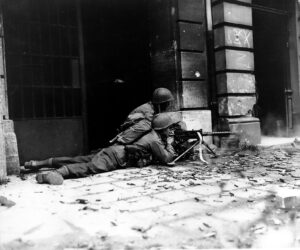
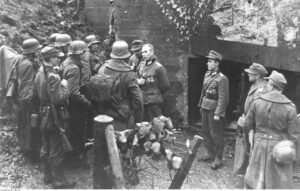 The Nazis were famous for taking no thought for the people around them, as long as they go what they wanted. Achen, Germany was one example of that lack of care and compassion. In October of 1944, the city has been incorporated into the Siegfried Line (known as the Hindenburg Line to the Americans). The Siegfried Line was the main defensive network on Germany’s western border.
The Nazis were famous for taking no thought for the people around them, as long as they go what they wanted. Achen, Germany was one example of that lack of care and compassion. In October of 1944, the city has been incorporated into the Siegfried Line (known as the Hindenburg Line to the Americans). The Siegfried Line was the main defensive network on Germany’s western border.
Fighting around Aachen began as early as the second week of September. It was a period of time known to the Germans as the “First Battle of Aachen.” At that time, the city was defended by the 116th Panzer Division. A panzer division was “a combined arms formation, having both tanks, (German: Panzerkampfwagen, which means armored fighting vehicle, usually shortened to “Panzer”), mechanized and motorized infantry, along with artillery, anti-aircraft and other integrated support elements.” The Panzer Division was under the command of General Gerhard von Schwerin. The proximity of Allied forces made the city officials very nervous, and quickly caused the majority of the city’s government officials to desert their post, long before the evacuation of its citizens was complete. While most of us would be furious over this desertion, Hitler had taken it one step further, by stripping each of the deserting officials of their rank and sending them to the Eastern front as privates. Rather a fitting punishment, but I seriously doubt if Hitler cared about the people. He wanted the officials there for war purposes. Then, in the greatest atrocity, instead of continuing the evacuation, von Schwerin decided to surrender the city to Allied forces. He would have had no idea if the Allies would trat the people kindly or not, but then he really didn’t care. However, on September 13, before he could deliver a letter of capitulation he had written, von Schwerin was ordered to launch a counterattack against American forces penetrating southwest of Aachen. Reluctantly he followed the orders, probably because he fear Hitler more than the Allied forces. He used elements of his panzergrenadier (the motorized infantry) forces. The German general’s Treasonous act when he attempted to surrender the city was irrelevant now, because his letter was never delivered. Unfortunately for him, it fell into the hands of Adolf Hitler, who ordered the general’s immediate arrest. He was replaced by Colonel Gerhard Wilck.
The United States’ VII Corps continued to push German defenses, despite the resistance they encountered on September 12th and 13th. Between September 14 and 16, the US 1st Infantry Division continued its advance in the face of strong defenses and repeated counterattacks, ultimately creating a half-moon arc around the city. Unfortunately, this slow advance came to a halt in late September, due to the supply problem, and the diversion of existing stocks of fuel and ammunition for Operation Market Garden in the Netherlands.
During what would then be known, to the Germans at least, the second Battle of Aachen, American and German forces in and around Aachen, Germany, fought for supremacy between October 2 and 21, 1944. The 
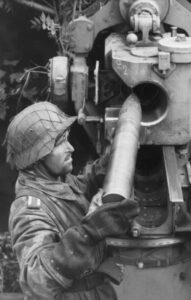 Allies needed the city to advance into the industrialized Ruhr Basin, whether they wanted to fight a battle in the city or not. Although most of Aachen’s civilian population was evacuated before the battle began, much of the city was destroyed and both sides suffered heavy losses. The people would have nothing to come home to. It was one of the largest urban battles fought by US forces in World War II. Aachen was also the first city on German soil to be captured by the Allies. The battle ended with a German surrender, but their tenacious defense significantly disrupted Allied plans for the advance into Germany. The Battle of Aachen had cost both the Americans and Germans dearly; the former suffered over 7,000 casualties, while the latter lost over 5,000 casualties and 5,600 taken prisoner.
Allies needed the city to advance into the industrialized Ruhr Basin, whether they wanted to fight a battle in the city or not. Although most of Aachen’s civilian population was evacuated before the battle began, much of the city was destroyed and both sides suffered heavy losses. The people would have nothing to come home to. It was one of the largest urban battles fought by US forces in World War II. Aachen was also the first city on German soil to be captured by the Allies. The battle ended with a German surrender, but their tenacious defense significantly disrupted Allied plans for the advance into Germany. The Battle of Aachen had cost both the Americans and Germans dearly; the former suffered over 7,000 casualties, while the latter lost over 5,000 casualties and 5,600 taken prisoner.
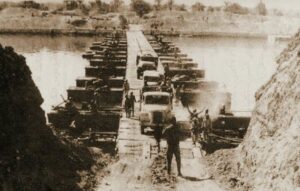
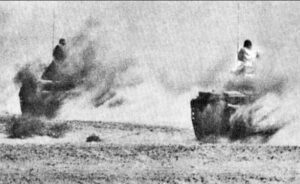 There has not been a time in my memory that was void of Middle East tensions, and perhaps there never been such a time since Biblical times. There have been many attempts and many negotiations trying to achieve Middle East peace, but none have ever really been successful. There have, however, been many wars, conflicts, and attacks on the countries of the Middle East, especially on Israel.
There has not been a time in my memory that was void of Middle East tensions, and perhaps there never been such a time since Biblical times. There have been many attempts and many negotiations trying to achieve Middle East peace, but none have ever really been successful. There have, however, been many wars, conflicts, and attacks on the countries of the Middle East, especially on Israel.
On October 6, 1973, in a surprise attack by Egyptian and Syrian forces on Israel, again threw the Middle East into turmoil. This particular attack threatened to bring the United States and the Soviet Union into direct conflict for the first time since the Cuban Missile Crisis in 1962. The United States and the Soviet Union had a tense relationship already, and although actual combat did not break out between the two nations, the events surrounding what became known as the Yom Kippur War seriously damaged United States-Soviet relations and all but destroyed then President Richard Nixon’s much publicized policy of détente (an end to hostilities).
Going into the war, Egypt and Syria, who were armed with the latest in Soviet weaponry, appeared to have the upper hand, and it looked like the two-front attack might bring victory to Egypt and Syria, who were looking to avenge themselves after their humiliating defeat in the Six-Day War of 1967. Nevertheless, Israeli counterattacks, aided by massive amounts of US military assistance, as well as disorganization among the Syrian and Egyptian forces turned the tide. The Israeli troops drove the Syrian troops back, and Syrians and seized the strategically important Golan Heights. The Israeli forces were even harder on the Egyptian army, forcing them to retreat back through the Sinai Desert, thousands of their troops were surrounded and cut off by the Israeli army.
As concerns deepened over the possibility of US-Soviet involvement in the conflict, Secretary of State Henry Kissinger, together with his Soviet counterparts, eventually arranged a shaky cease-fire. The Israeli troops had no intention of ending their siege of the Egyptian troops, who by this time were low on food and medicine, the Soviets threatened to take unilateral action to rescue them. This brought the situation close to the boiling point, and with tempers flared both in Washington and Moscow, the US military forces went to a Stage 3 alert. In case you didn’t know it, Stage 1 is war, so the volatile situation was about to explode. The threat of war with the US caused the Soviets to back down on their threat, but the damage to relations between the two nations was serious and would not be resolved for a long time, if ever. I’m still not sure that relationship is on anything but shaky ground.
Nevertheless, Kissinger worked feverishly to bring about a peace settlement between Israel, Syria, and Egypt. In what later became known as “shuttle diplomacy,” the secretary of state flew from nation to nation 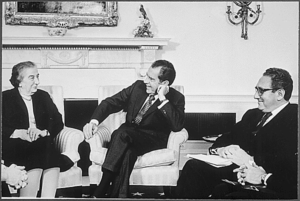
 hammering out the details of the peace accord. Finally, a little more comfortable with things, Israel began to withdraw its troops from some of their positions in both the Sinai and Syrian territory. For their part, Egypt promised to forego the use of force in its dealings with Israel. Syria only grudgingly accepted the peace plan, but they remained adamantly opposed to the existence of the Israeli state…a feeling that still exists among many Middle Eastern nations to this day.
hammering out the details of the peace accord. Finally, a little more comfortable with things, Israel began to withdraw its troops from some of their positions in both the Sinai and Syrian territory. For their part, Egypt promised to forego the use of force in its dealings with Israel. Syria only grudgingly accepted the peace plan, but they remained adamantly opposed to the existence of the Israeli state…a feeling that still exists among many Middle Eastern nations to this day.

 Not every man can say he shares his birthday with his son-in-law or father-in-law, but my uncle, Jim Wolfe and his son-in-law, Bernard “Shorty” Cameron got to say that. Shorty became Uncle Jim’s son-in-law, on December 28, 1969, when he married my cousin Shirley Cameron. Uncle Jim and Shorty always got along very well…even living next door to each other for most of their lives. When it came to Uncle Jim needing help due to his Alzheimer’s Disease, Shorty was one of the people who helped him. I think Uncle Jim and Shorty always liked that they had the same birthday. They liked doing things together like taking trips, the whole family sometimes came for surprise visits. It was always a great time.
Not every man can say he shares his birthday with his son-in-law or father-in-law, but my uncle, Jim Wolfe and his son-in-law, Bernard “Shorty” Cameron got to say that. Shorty became Uncle Jim’s son-in-law, on December 28, 1969, when he married my cousin Shirley Cameron. Uncle Jim and Shorty always got along very well…even living next door to each other for most of their lives. When it came to Uncle Jim needing help due to his Alzheimer’s Disease, Shorty was one of the people who helped him. I think Uncle Jim and Shorty always liked that they had the same birthday. They liked doing things together like taking trips, the whole family sometimes came for surprise visits. It was always a great time.
Since Uncle Jim and Aunt Ruth moved away from Casper when my sisters and I were just kids, I suppose that 
 they always seemed like world travelers to us. I don’t think they ever really traveled to anyplace exotic, unless maybe Uncle Jim did when he was in the service. Nevertheless, he always seemed to know a lot about a lot of places, and we really loved hearing the stories he had to tell. I always wondered how he could know so much about so many things. I suppose that he might have been pulling our legs with his knowledge, but it always seemed plausible, so we believed him. I will always remember how much we loved to listen to him tell his tales, be they truth or fiction.
they always seemed like world travelers to us. I don’t think they ever really traveled to anyplace exotic, unless maybe Uncle Jim did when he was in the service. Nevertheless, he always seemed to know a lot about a lot of places, and we really loved hearing the stories he had to tell. I always wondered how he could know so much about so many things. I suppose that he might have been pulling our legs with his knowledge, but it always seemed plausible, so we believed him. I will always remember how much we loved to listen to him tell his tales, be they truth or fiction.
Uncle Jim was a gentle man, who loved kids. He treasured each and every one of his children and grandchildren. They were the lights of his life…after his beloved wife, my Aunt Ruth, that is. Uncle Jim loved Aunt Ruth so much. It was always so sweet to see them together. They did everything together, from working 
 around their place to the many miles they traveled. It broke his heart when she left us in 1992, at just 66 years old. While he lived for another twenty-one years before he joined her in Heaven, I don’t really think that he was ever the same. He eventually slipped into his own memory world, where Aunt Ruth was still alive and with him. Today would have been Uncle Jim’s 101st and Shorty’s 81st birthday. Happy birthday in Heaven Uncle Jim and Shorty!! Try to stay out of trouble today!! I know the party will be great anyway. We love and miss you very much.
around their place to the many miles they traveled. It broke his heart when she left us in 1992, at just 66 years old. While he lived for another twenty-one years before he joined her in Heaven, I don’t really think that he was ever the same. He eventually slipped into his own memory world, where Aunt Ruth was still alive and with him. Today would have been Uncle Jim’s 101st and Shorty’s 81st birthday. Happy birthday in Heaven Uncle Jim and Shorty!! Try to stay out of trouble today!! I know the party will be great anyway. We love and miss you very much.

 No one wants to think about an innocent person going to prison for a crime they did not commit, and I like to think that it doesn’t happen very often, but I think there was a time when it was a little more common that it is these days. While it may not happen as often these days as it used to, more and more of these wrongful incarcerations are coming to light these days, because of DNA testing. Michael Morton (born August 12, 1954) was convicted in a Williamson County, Texas court in 1986, of murdering his wife, Christine Morton. He never gave up the fight. He maintained in innocence until the end, and in the end, it was proven that he was in fact, innocent. Unfortunately, that did not mean that he was spared a prison sentence. He actually spent almost 25 years behind bars, sadly.
No one wants to think about an innocent person going to prison for a crime they did not commit, and I like to think that it doesn’t happen very often, but I think there was a time when it was a little more common that it is these days. While it may not happen as often these days as it used to, more and more of these wrongful incarcerations are coming to light these days, because of DNA testing. Michael Morton (born August 12, 1954) was convicted in a Williamson County, Texas court in 1986, of murdering his wife, Christine Morton. He never gave up the fight. He maintained in innocence until the end, and in the end, it was proven that he was in fact, innocent. Unfortunately, that did not mean that he was spared a prison sentence. He actually spent almost 25 years behind bars, sadly.
On the afternoon of August 13, 1986, a neighbor found 31-year-old Christine Morton beaten to death in her bed in the Williamson County, Texas, home near Austin, that she shared with Michael, a grocery store manager, and their 3-year-old son, Eric. The investigation began, and six weeks later, Morton, who had no criminal record or history of violence, was arrested for Christine’s murder. At trial, the prosecution contended Morton had slain his wife of seven years after she refused to have sex with him on the night of August 12, his 32nd birthday. Morton stated repeatedly that he had nothing to do with his wife’s death and said an intruder must have killed her after he left for work early on the morning of August 13. No witnesses or physical evidence linked Morton to the crime. There wasn’t anything circumstantial or ever really anything alleged to connect him to the crime, except that he had access to the home. Nevertheless, Michael Morton was convicted on February 17, 1987, and sentenced to life behind bars. So began his nightmare.
During his trial and subsequent time in prison, Morton’s defense team asked the state to test DNA on a variety of items, including a blood-stained bandanna found by police the day after the murder at an abandoned construction site close to the Morton home. For whatever reason, the Williamson County district attorney successfully blocked all requests for testing until 2010, when a Texas appeals court ordered that testing on the bandana take place. The team’s persistence finally paid off. The test results revealed the bandana contained Christine Morton’s blood and hair, along with the DNA of another man, Mark Alan Norwood, who was a felon with a long criminal record. Norwood had worked in the Austin area as a carpet layer at the time of the murder.
Finally, after waiting almost 25 years for real justice, Michael Morton was released on October 4, 2011. A month after Morton was freed, Norwood, who was by then 57, was arrested for Christine Morton’s killing. In March 2013, he was found guilty of her murder and sentenced to life in prison. Based on DNA evidence, Norwood also was indicted for killing a second woman, Debra Baker, whose 1988 murder in Austin had remained unsolved. Like Morton, Baker was bludgeoned to death in her bed. She lived just blocks from Norwood at the time of her murder. Michael Morton was officially exonerated in December of that year.
After a yearlong investigation into prosecutor, Ken Anderson, the State Bar of Texas filed a disciplinary petition against Ken Anderson in October 2012. By then, the prosecutor was a Texas district, elected in 2002. The Texas State Bar alleged that Anderson had withheld various pieces of evidence from Morton’s attorneys, including a transcript of an August 1986 taped interview between the case’s lead investigator and Morton’s mother-in-law, in which she stated that Morton’s then 3-year-old son, Eric had told her in detail about witnessing his mother’s murder and said his father was not home at the time. Anderson managed to pull off a plea deal to settle the charges against him. He agreed to serve 10 days in jail, perform 500 hours of community service, give up his law license and pay a $500 fine. I think that is an outrageous miscarriage of justice. He had knowingly withheld evidence that cost another man 25 years of his life. He should have had to serve the same length of time.
Morton was later able to re-establish contact with his son, who had cut ties with him when he was fifteen, because he then believed that he had not remembered the incident correctly, and it was his dad who had killed 
 his mom. A further miscarriage of justice that was handed down to the elder Morton. He had not only lost 25 years of his own life, but an additional 13 years of his son’s life. Thankfully, Christine Morton’s sister adopted Eric Morton, so his dad was able to find his son when he got out of prison. When his was released, Morton lived with his parents in Liberty City, Texas for a while, before moving to Kilgore, Texas. In 2013, Morton married Cynthia May Chessman, who he met at his church.
his mom. A further miscarriage of justice that was handed down to the elder Morton. He had not only lost 25 years of his own life, but an additional 13 years of his son’s life. Thankfully, Christine Morton’s sister adopted Eric Morton, so his dad was able to find his son when he got out of prison. When his was released, Morton lived with his parents in Liberty City, Texas for a while, before moving to Kilgore, Texas. In 2013, Morton married Cynthia May Chessman, who he met at his church.

 I’m sure most of us have seen a covered bridge…at least in pictures. Most people think of them as being nostalgic, and I do too. They remind me of times long gone, but why were bridges covered in the first place? It wasn’t to lend a romantic flair to the bridge, you know. No, the real reason for covered bridges actually traces back to what the bridge is made of. Wooden structures then and now are exposed to harsh weather and subject to wear and tear. Covering the bridge does two important things. The cover protects the wooden deck…the surface that people and vehicles travel on. It also protects the truss system, which is the lattice framework under and around the bridge that supports the deck, helping the structure last longer. The roof and side elements were replaceable as long as the support structure remained strong. If the support structure weakens, the bridge will have to be rebuilt, because rotting wood cannot be made strong again. This is one of the main reasons that covered bridges have slowly given way to steel bridges over time. Steel structures hold up years longer than wood.
I’m sure most of us have seen a covered bridge…at least in pictures. Most people think of them as being nostalgic, and I do too. They remind me of times long gone, but why were bridges covered in the first place? It wasn’t to lend a romantic flair to the bridge, you know. No, the real reason for covered bridges actually traces back to what the bridge is made of. Wooden structures then and now are exposed to harsh weather and subject to wear and tear. Covering the bridge does two important things. The cover protects the wooden deck…the surface that people and vehicles travel on. It also protects the truss system, which is the lattice framework under and around the bridge that supports the deck, helping the structure last longer. The roof and side elements were replaceable as long as the support structure remained strong. If the support structure weakens, the bridge will have to be rebuilt, because rotting wood cannot be made strong again. This is one of the main reasons that covered bridges have slowly given way to steel bridges over time. Steel structures hold up years longer than wood.
A covered bridge is a timber-truss bridge with a roof, decking, and siding, so most covered bridges actually look like a building over water. They are an almost complete enclosure, with the exception of their two ends, and sometimes windows. Uncovered wooden bridges typically have a lifespan of only 20 years because of the effects of rain and sun, but when a bridge is covered, it could last over 100 years. In fact, the oldest covered bridge in the United States is Hyde Hall Covered Bridge, which is on the grounds of Glimmerglass State Park in Cooperstown. It was built by George Clarke in 1825 on what was then the private property of Hyde Hall.
Nevertheless, while covered bridges last a long time, in the United States, only about 1 in 10 survived the 20th century. It wasn’t because they were dilapidated, but it was due to deliberate replacement, neglect, and the 
 high cost of restoration. Covered bridges have a long history, and they can be found throughout Europe and especially North America in places like New England, the Mid-Atlantic and the regions around the Great Lakes…mainly because these areas are very wooded, and so the building material there is plentiful. I think it’s rather sad that the covered bridges have almost become extinct…such a loss to history.
high cost of restoration. Covered bridges have a long history, and they can be found throughout Europe and especially North America in places like New England, the Mid-Atlantic and the regions around the Great Lakes…mainly because these areas are very wooded, and so the building material there is plentiful. I think it’s rather sad that the covered bridges have almost become extinct…such a loss to history.
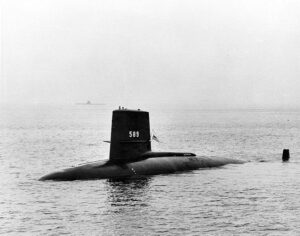
 USS Scorpion (SSN-589) was a Skipjack-class nuclear-powered submarine that served in the United States Navy, and the sixth vessel, and second submarine, of the US Navy to carry that name. It was also the fourth nuclear powered submarine to mysteriously go missing in 1968. Scorpion was lost with all its crew, on May 22, 1968. Scorpion is one of two nuclear submarines the US Navy has lost, the other being USS Thresher. The other nuclear-powered submarines to go missing in 1968 at the height of the Cold War were Israeli submarine INS Dakar, the French submarine Minerve, and the Soviet submarine K-129. At the time Scorpion went missing when she was sent to surveil the Soviet submarine K-129, which had apparently already gone missing earlier in the year. The wreckage of USS Scorpion is still at the bottom of the North Atlantic Ocean…with all its armaments and nuclear engine.
USS Scorpion (SSN-589) was a Skipjack-class nuclear-powered submarine that served in the United States Navy, and the sixth vessel, and second submarine, of the US Navy to carry that name. It was also the fourth nuclear powered submarine to mysteriously go missing in 1968. Scorpion was lost with all its crew, on May 22, 1968. Scorpion is one of two nuclear submarines the US Navy has lost, the other being USS Thresher. The other nuclear-powered submarines to go missing in 1968 at the height of the Cold War were Israeli submarine INS Dakar, the French submarine Minerve, and the Soviet submarine K-129. At the time Scorpion went missing when she was sent to surveil the Soviet submarine K-129, which had apparently already gone missing earlier in the year. The wreckage of USS Scorpion is still at the bottom of the North Atlantic Ocean…with all its armaments and nuclear engine.
The Cold War is a term commonly used to refer to a period of geopolitical tension between the United States and the Soviet Union and their respective allies, the Western Bloc and the Eastern Bloc. The first phase of the Cold War began shortly after the end of World War II in 1945. The United States and its allies created the NATO military alliance in 1949 in the apprehension of a Soviet attack and termed their global policy against Soviet influence containment.
Following World War II, tensions were running high between world powers. It is thought that if there was ever a time when a real possibility of a nuclear attack existed, it was during the Cold War. This meant that countries were frantically looking for any advantage they could use to take over their competitors. One way to watch the other countries was to Surveil beneath the waves where they could be more hidden. This surveillance included the use of submarine crews. That, of course, explains the reason for mysterious disappearance of four subs from four different countries virtually at the same time.
The first disappearance was the INS Dakar from Israel, which went down just east of Crete on January 25, 1968. Dakar’s wreckage was found in 1991, but no official cause for the sinking was determined. Next, The French sub Minerve disappeared about an hour outside of Toulon on January 27, 1968. That wreckage was found in 2019, and it showed the hull had separated into three sections. When the French government made the decision to leave the wreck, any chance of answers was eliminated. The Soviet K-129 disappeared earlier in the year, so maybe USS Scorpion was looking for it. Nevertheless, on May 22, 1968, the disappearance conspiracy of 1968 was brought to a close, when USS Scorpion. The submarine would not be fount until October of 1968. The Navy looked into the disaster, but in the end the official court of inquiry said the cause of the loss could not be determined with certainty. Still, there are several theories on what might have happened. One centered around a malfunction of a torpedo. Others suspected poor maintenance may have been the culprit, citing the rushed overhaul.
That was the last report anyone heard about the submarine. After decades of research and investigation, the US Navy has never changed its report that a catastrophic event caused the sinking. Nevertheless, there are those who believe the Scorpion was taken out by the Soviets in retaliation for perceived attack on the K-129 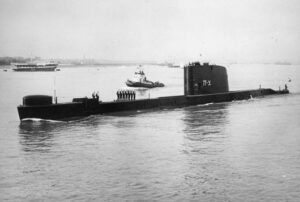
 submarine earlier in the year. Neither country will admit or deny any direct action relating to the submarine sabotage, but something happened during the first half of 1968. Four nuclear-powered submarines, from four different countries just don’t start sinking for no reason, and yet, no reason was ever determined. They just sunk.
submarine earlier in the year. Neither country will admit or deny any direct action relating to the submarine sabotage, but something happened during the first half of 1968. Four nuclear-powered submarines, from four different countries just don’t start sinking for no reason, and yet, no reason was ever determined. They just sunk.

